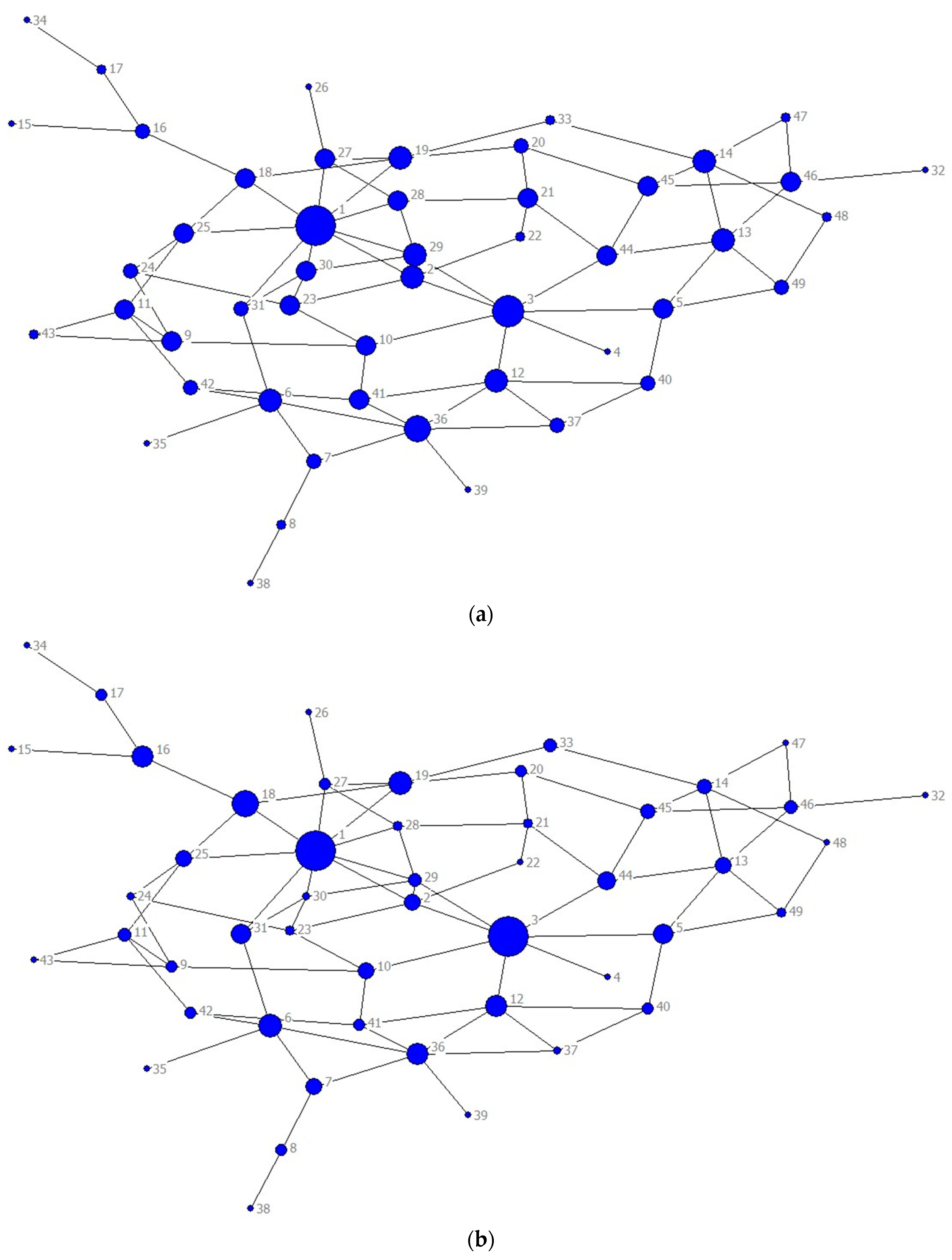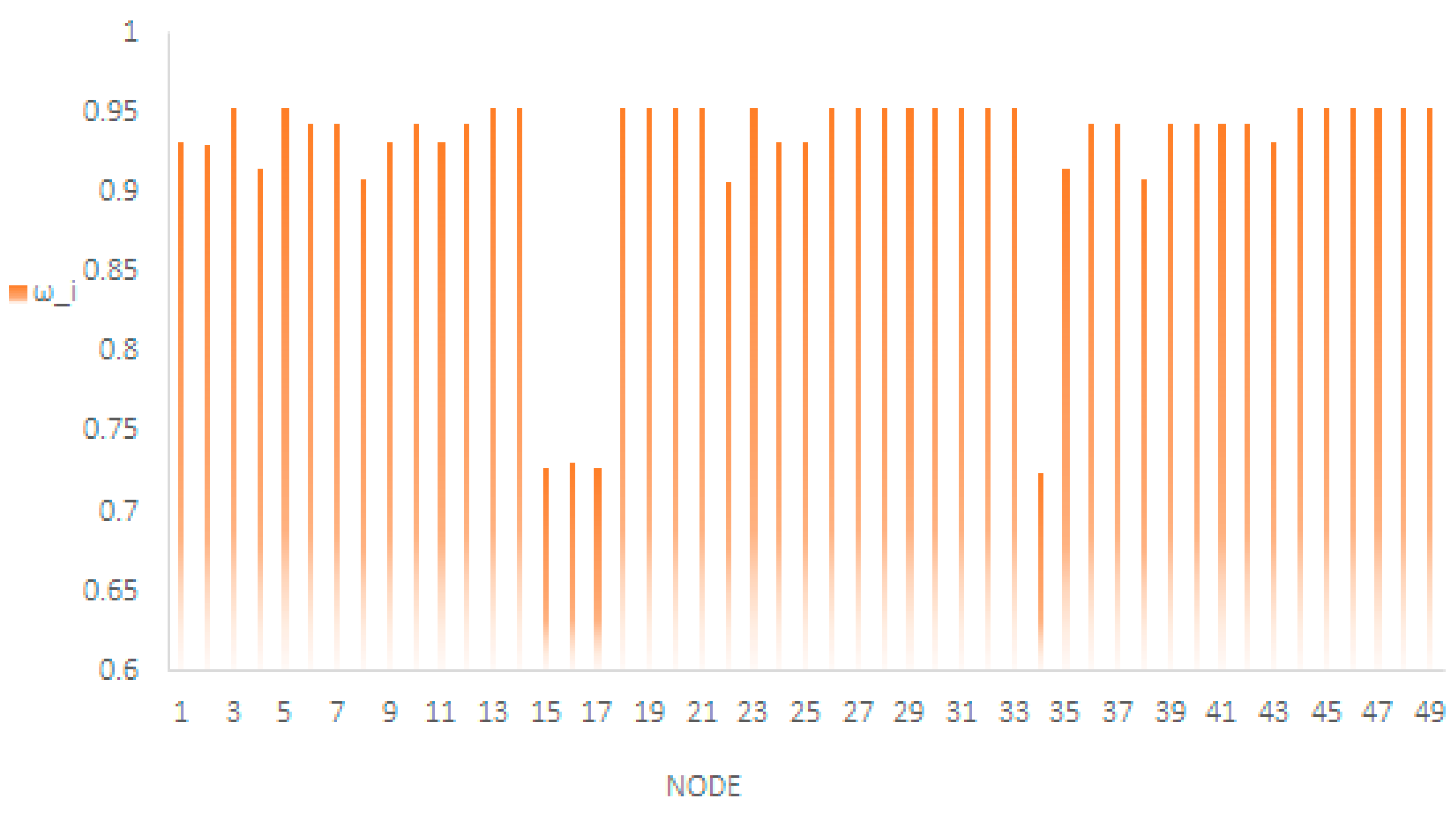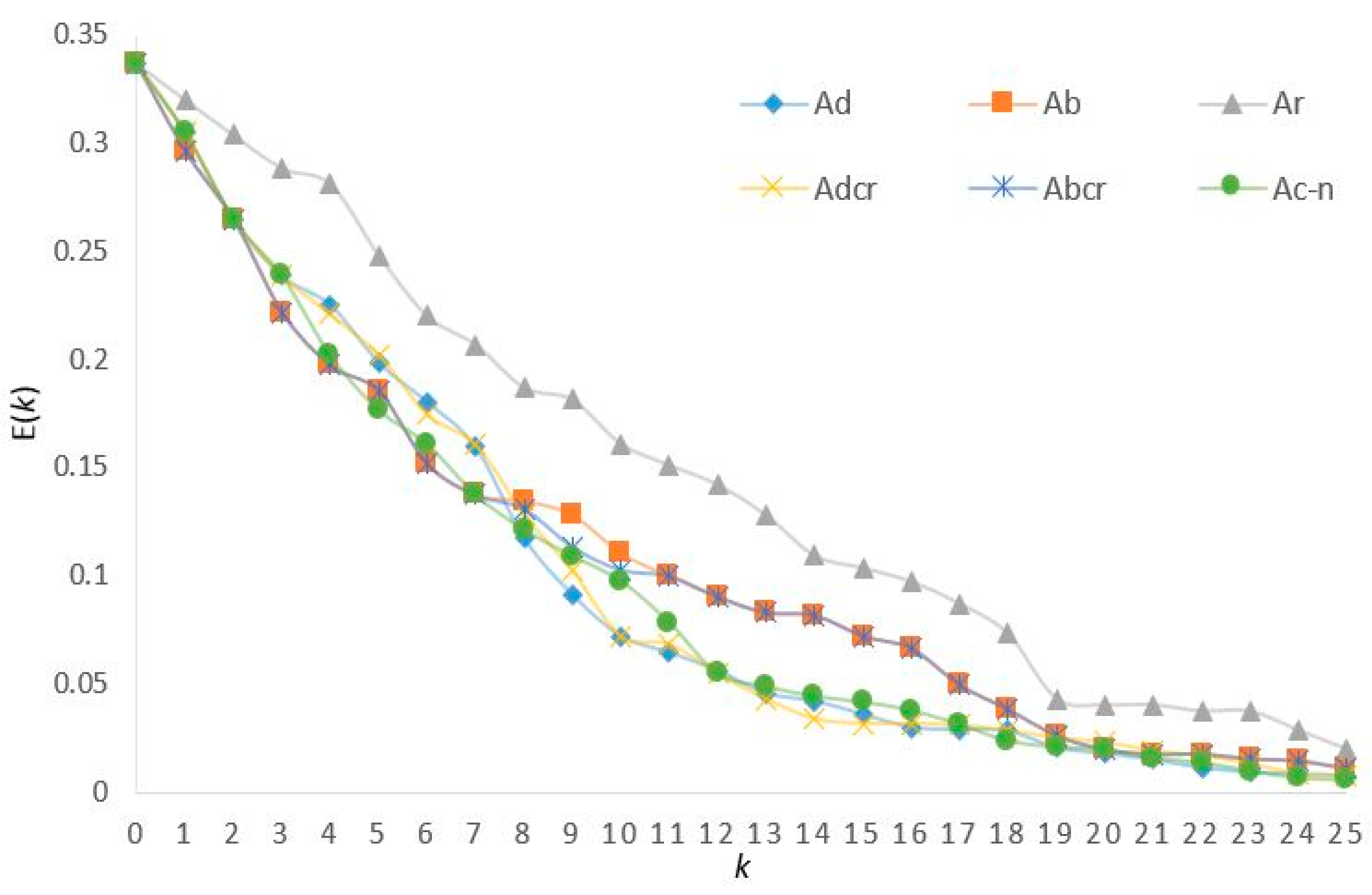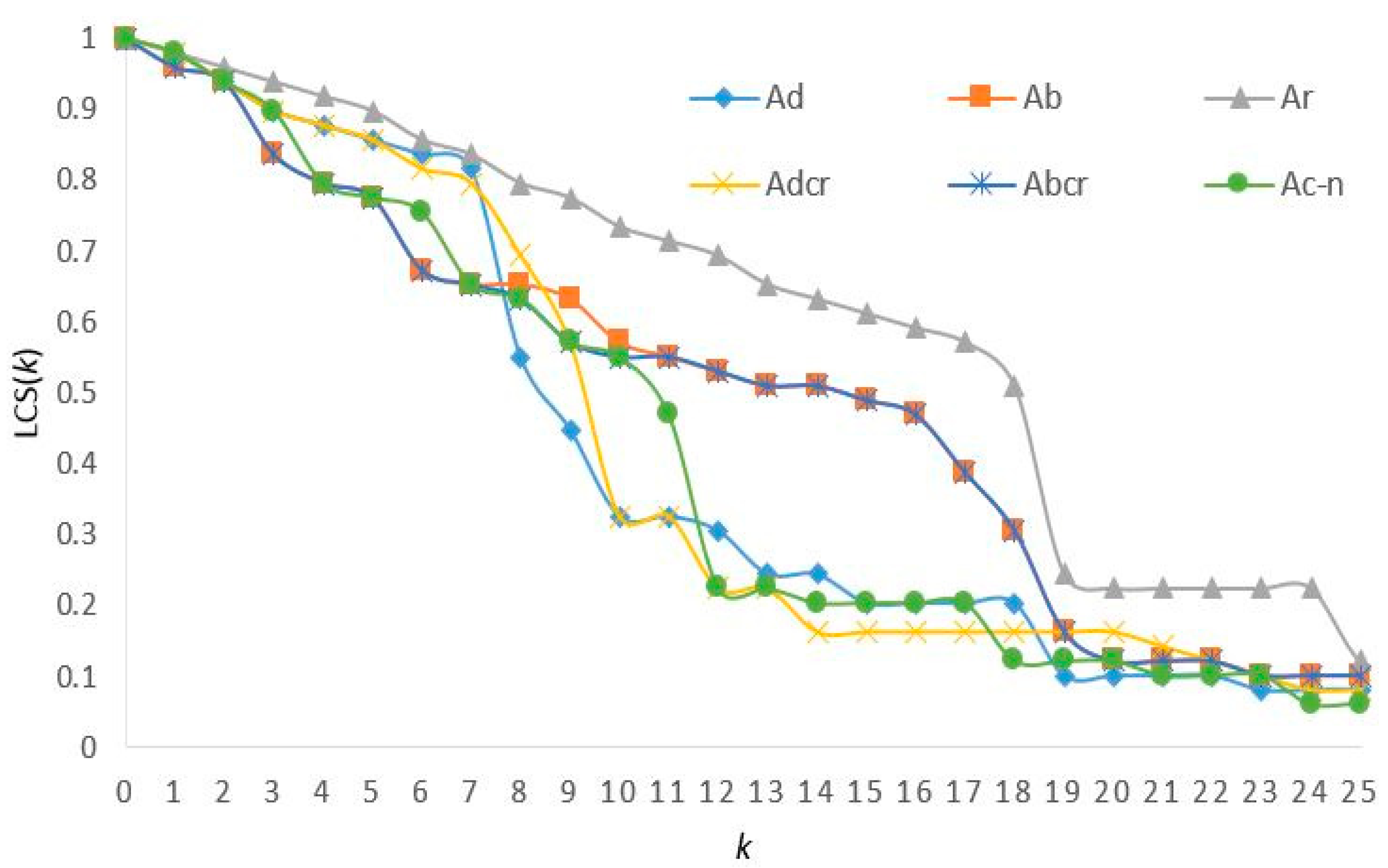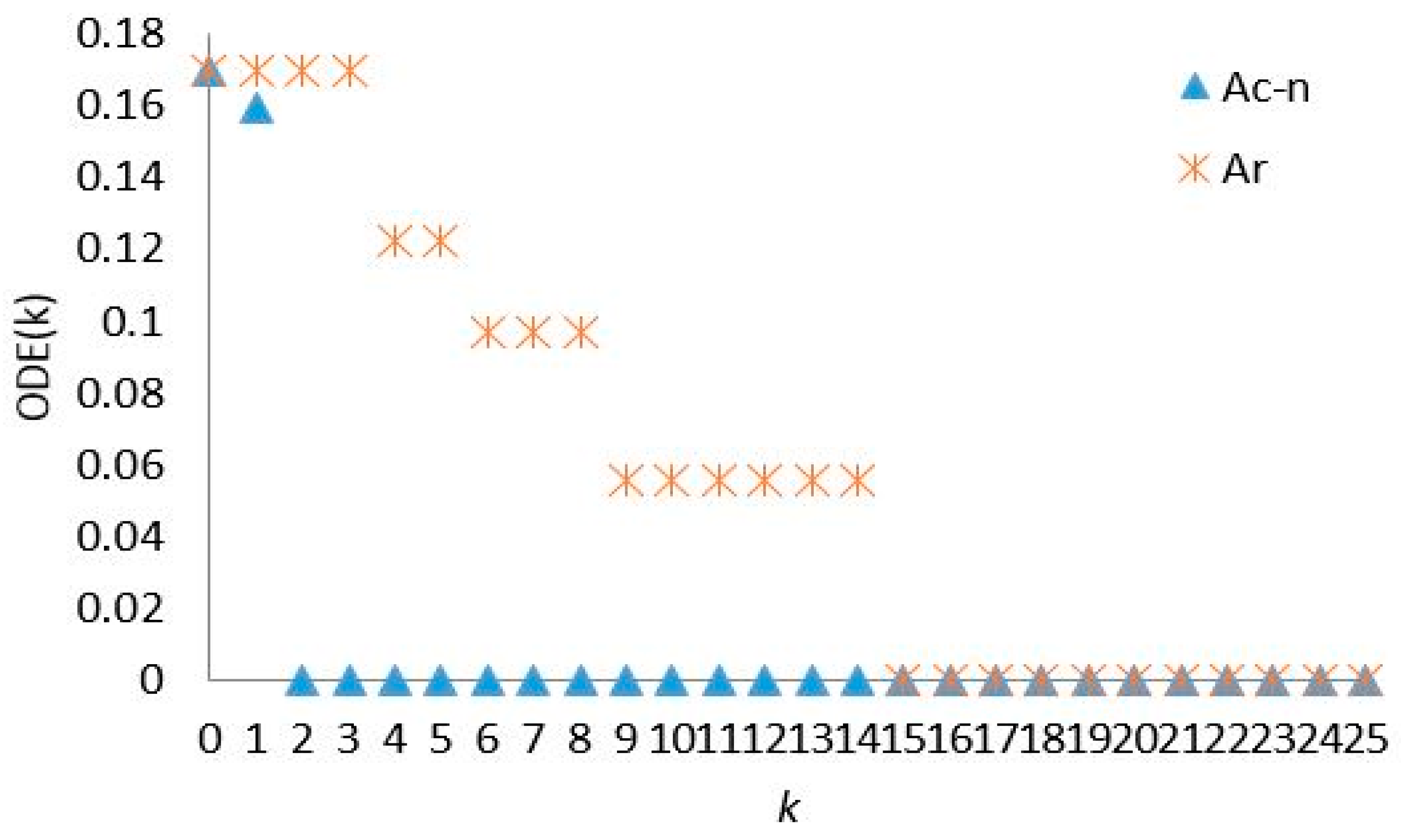1. Introduction
In recent years, regional integration, which takes the urban agglomeration as the main form, is a major feature of China’s regional economic and social development [
1]. The integration of Beijing, Tianjin and Hebei is a major national strategy for the future to build the capital economic circle, in order to realize the complementary advantages of the Beijing-Tianjin-Hebei region (BTHR), as well as to promote the development of the northern hinterland. The integration of traffic is the skeleton system of the BTHR. In particular, rail transit will play an important role in the development of the integration of the BTHR, and to build “BTHR on the track” is the key area for the coordinated development. However, rail transit, like other infrastructure, faces many threats, including natural disasters, terrorist attacks, or random failures, which calls for evaluation on the robustness in order to attain sustainable development within the area. According to statistics, BTHR is a natural disaster-prone area, and the natural disasters that directly affect traffic in BTHR are floods, frosts and snowstorms, which generally have huge impact on society. In 2012, the Beijing “7.21” heavy rain caused direct economic losses of 11.64 billion yuan [
2]. In addition, rail and public transport networks are generally more sensitive to disruptions than road networks [
3], rail accidents not only cause traffic delays of the direct line(s), but also have a wider impact on passengers in other stations along the line(s) or even potential passengers, which generally generates larger social impact [
4]. Therefore, a simulation model of different damage scenarios is proposed according to different hazards in BTHR, and the analysis of vulnerability of the whole planning rail transit network is important for identifying protection strategies.
The concept of vulnerability was proposed in social economics research at the beginning, especially in terms of psychology, military science, natural disasters and climate change. Vulnerability is often studied together with threats such as danger and disaster (e.g., terrorist attacks on traffic or power systems, financial crisis, pandemic spatial diffusions, natural disasters, etc.) [
5]. Vulnerability analysis refers to the susceptibility of the dynamic system to extreme events and the impact of the propagation in the network. The study of vulnerability was first proposed in transportation network by Berdica in 2002. Berdica believes that vulnerability is closely related to the availability of services, especially the lack of adequate service provision [
6]. In recent years, literature on vulnerability has emerged in the area of critical infrastructure networks [
7,
8,
9,
10,
11]. However, the resilience and vulnerability in the transportation system are not easy to measure or quantify, and recent research on vulnerability evaluation has failed to draw clear conclusions [
3]. Aura Reggiani, Peter Nijkamp and Diego Lanzi systematically combs the conceptual framework of traffic resilience and vulnerability, reviews the current research situation and classifies research methods into common methods and special methods (conclusions from realistic networks or case studies), according to whether they can be easily used in a variety of environments [
9].
Previous research reveals that connectivity and accessibility are common parts of dynamic traffic system analysis. The complexity of the network is a proper way to study the vulnerability of the traffic system. The topological characteristics of traffic networks can be used as the basis for studying the vulnerability of traffic systems, in order to find the critical links or key nodes and the vulnerability conditions associated with these links or nodes, which can affect the vulnerability of the entire network. Due to the operability of vulnerability assessment, scholars have carried out extensive research on the vulnerability analysis of traffic networks. Based on the theory of vulnerability, scholars have studied the actual road network, public transportation network and rail transit network [
7,
12,
13,
14,
15,
16,
17]. In addition, simulations are applied to the actual road network, route network and logistics network. Cats, O defines defined the robustness of the system as the capacity to absorb disturbances with a minimal on system performance [
10]. It is found that predecessors’ research is based on the evaluation of the vulnerability of the existing road network in a city, but that the robustness evaluation of the alternative path in the transportation development plans has not been studied. Cats proposed a method by full-scan of all possible scenarios of link failure to evaluate the robustness of alternative public transport links. The method was used to evaluate the robustness implications of a substantial development plan of Stockholm multi-modal rapid urban rail network in 2025.
2. Literature Review
In a large number of studies, scholars have developed the method of vulnerability into two aspects: the first is to study the vulnerability of the system itself, which mainly studies the influence of traveler under various travel conditions, such as traffic accident, technical failures, natural disasters. The influence is usually expressed in the form of probability distribution (connectivity reliability, travel time reliability, capacity reliability, etc.) [
18,
19,
20]; The second, in contrast, is focusing on the unreliability of the research system, aiming to study the potential weak points (critical nodes/links). Scholars have found that the connectivity of network will be heavily influenced if there is one or several weak/critical points. Such influence may be resulted in the functional deterioration of the nodes/links, and will lead to long-term impacts to the social economics. In addition, short-term influence would also be initiated because of temporary threats such as bad weather, technical failures or accidents. Moreover, some scholars and institutes pay attention to the operational transit domain.
From the perspective of operational transit, some projects have done better work in terms of analyzing and applying real-traffic data. ON-TIME is an European Union (EU)-funded project aiming at developing new methods and processes to help decrease overall delays on Europe railway transit, and one of its objectives is to provide robust and resilient timetables capable of coping with disrupt operations on transit [
21]. Hamza Achit used the data provided by the National Security System in France; he analyzed the economic consequences for almost all road victims in France, and identified homogenous categories of victims according to these long-run consequences [
22]. Yoshitsugu Hayashi established a map where different areas were identified according to their eco-sufficiency. These areas are locations for retreatments, which are useful to policy makers as they can help with actions for sustainable mobility [
23]. Rayane Wehbé found that one of the causes of the increase in road accidents in Lebanon was the inappropriate geometry of the road infrastructure; he advocated the application of the audit method and recommended to adapt it to each step of the road infrastructure project [
24].
Aura, Peter and Diego review literature of vulnerability in transportation system, and they summarize different definitions and methodological framework of measurement or evaluation of resilience and vulnerability [
9].
According to Lars-Göran Mattsson and Erik Jenelius, there are two traditional approaches to the study of the vulnerability of the transport system. One is based on the study of graph theory and traffic network topology, while the other studies the response of travelers after the system or the supply-demand relationship is disturbed by using complex models. The latter approach describes the influence on vulnerability after disturbance more completely, but the computational demand is also higher [
3].
Liu Hong et al. extracted 399 sites from China Railway Network and 500 linked topological networks; Monte Carlo simulation method was used to simulate the occurrence of floods in all provinces in China based on historical data. The vulnerability of rail transit network is evaluated through the assessment of the occurrence of floods in each province [
11].
A dynamic agent-based bus assignment model was used by Cats, O and Jenelius to identify a subset of central links and completed a detailed dynamic robustness analysis. Taking the same method as a component of the continuous process, Cats, O and Jenelius identified the locations where the reserve capacity should be configured and the redundancy could be increased, in order to improve the robustness of the network. The physical meaning of the elements in the adjacency matrix is considered as the traffic impedance of the link, and the traffic impedance is deterministic at the traffic planning stage. The all-or-nothing assignment method is taken for network traffic assignment under destruction, with the computing advantage for large-scale network [
8,
13]. Yang, Y.H. et al. evaluated the robustness of rail transit in Beijing with complex network theory, and designed a method of weighting index of node importance, which can guide the site selection [
16]. Cats, O performed the full-scan of network links, and analyzed the impacts of each disruption in terms of how the disruption influences the travel experience of population (cut-off, delayed, unaffected). He proposed three performance indicators of the network system: Share of cut-off demand; Share of delayed passengers; Average travel time; and the evaluation of robustness of the rapid rail-bound transport system of Stockholm, Sweden 2025, which was carried out based on the above indicators [
10]. Oriol Lordan et al. compared the performances of several node selection indicators, together with a new indicator based on Bonacich power centrality. Identified the critical airports for the global ATN of November 2011–November 2012 [
15]. Irina Petreska et al. started from the similarity of structural dynamics and complex networks, the network node/link busy degree is proposed on the basis of the modal equation, which could be used as the measure of vulnerability reflecting the influence on neighboring nodes [
25]. Sun, D. et al. defined that the station vulnerability is the change of the topological efficiency and the influence of passenger flow after attacked, as well as the probability of station being attacked. A vulnerability evaluation model was proposed by introducing metro interchange and passenger flow, and was evaluated based on a case study of Shanghai Metro with full-scale network and real-world traffic data [
4].
Researchers have also studied the system robustness or vulnerability based on complex network theory, in the areas of electric system, communication system, command system and social network other than transportation system. Shuliang Wang et al. took central China power grid as an example gave the algorithm for detecting community structure, and studied the vulnerability analysis of power systems under terrorist attacks [
12]. Jian Li et al. compared the connectivity reliability (CR) and topological controllability (TC) of infrastructure systems in terms of three aspects: topology, robustness, and node importance, and developed a controllability index and a controllability-based node importance metric [
26]. Sudha Gupta et al. explored the hidden geometry of current flow path for analysis of vulnerability in power system, and defined the Power Flow Index and the Vulnerability Index to analyze and measure the impact of line tripping on grid vulnerability, which may lead to cascade failure in smart power transmission system [
27].
Though previous studies are quite systematic and detailed, limitations and space for improvements still remain. Firstly, some studies are only interested in topographical characteristics of the network while ignoring the other factors which would affect the importance of nodes, such as connectivity reliability which is a key component in transport. Secondly, the combination of node connectivity reliability and node centrality has not been studied thoroughly, thus the measurement used to identify key node importance is remained to be established. In the real operational transportation network, the connect probability of routes will be influenced related to natural or human factors, so as to influence the node connect reliability. One may lack considerations of real operating conditions if one only measures the node importance based on node centrality of transportation network topological structure. The real-traffic node importance should be measured based on the combination of node connectivity reliability (based on route connectivity probability) as well as the node centrality measurement.
The rest of the paper is arranged as below: the main methodology is proposed in
Section 3, as well as the abstraction of rail network in the BTHR. In
Section 4, the model is validated based on the case study of the BTHR rail transit planning, and the results and corresponding analysis are presented. Finally, some conclusions and future research prospects are put forward in
Section 5.
5. Conclusions
The method of critical node identification considering node connectivity reliability is proposed in this paper. A comprehensive measure of Core-Nodes is proposed based on 4 measures to identify critical nodes. The connectivity reliability of 49 nodes in the BTHR rail transit plan network is simulated by Monte Carlo simulations. The critical nodes in the BTHR rail transit plan network are analyzed based on network centrality measure. Combining the above measures together, we calculate the Core-Nodes in the BTHR rail transit plan network. Finally, the network vulnerability is evaluated based on measures of network efficiency and largest component size. Some findings and conclusions are summarized as below:
- (1)
The critical node identification considering node connectivity reliability is based on connectivity probability of network links. As the output nodes from Monte Carlo is based on the measure of network centrality, the sequencing of critical nodes is similar with that of network centrality when the centrality and connectivity reliability are relatively high. However, when the connectivity reliability is low, the method of critical node identification can take network centrality into consideration as well as the real connectivity reliability.
- (2)
The attack modes based on random failure and 5 strategic modes provide simulations of different forms of destructions on the BTHR rail transit plan network. The network performances of E(k) and LCS(k) are simulated, and the results indicate that the network retains robustness under random failure. Under strategic attacks, though, the network shows ability to resist attack, the network vulnerability is relatively higher. An interesting finding from the measure of ODE(k) concerning regional exterior transit demand shows that failure of two critical nodes (Beijing and Tianjin) would cause fatal effect on the whole network.
- (3)
The critical node rankings are quite different under different measures, such as degree/betweenness node-based metrics that have various emphases. However, when evaluating the network vulnerability, different aspects of influence should be taken into consideration. The network performance simulation under attack mode of Core-Nodes provides relatively balanced outputs between measures based on degree and on betweenness, from the perspective of either E(k) or LCS(k). Therefore, the measure of Core-Nodes is more suitable for critical node identification, as it represents for comprehensive network performance.
- (4)
Although both centralities of Beijing and Tianjin are high, the influence of their failures on the whole BTHR rail transit network is only 6–21%. However, with multiple nodes failures, especially when the 8th node is destroyed, have huge impact on network performance, and the impact on E(k) is larger than that of LCS(k). The finding indicates that the robustness in the BTHR rail transit plan network is quite strong, though the impact of critical nodes failure on shortest paths is relatively high, the influence on partial nodes connectivity is quite small.
- (5)
Considering regional network performance, the protection and emergency rescue preparation are not only essential for several large nodes such as Beijing and Tianjin, but is also important for nodes of Hengshui, Shijiazhuang, Miyun, Cangzhou, Huailai and Tangshan which have huge impact on the whole network shortest paths and connectivity. In terms of the regional exterior transit or transit towards the sea, Tianjin becomes a life-and-death node which should be paid large attention to. The safety protection and emergency rescue preparation should be strengthened, and multiple branch links connected to the sea should be constructed in order to raise the robustness of the network.
In the domain of transportation network, the identification of critical nodes is of great importance to the sustainable development of transportation infrastructures, as we can raise the network robustness by setting up rescue stations accordingly, increasing redundant lines or other lines in the network. The method of critical node identification in this study is expected to present the locations of vulnerable nodes combined with real network conditions. In addition, the methodology can also be applied to studies on system vulnerability evaluation of other areas, such as electricity, communication and infrastructure constructions.
Further studies may be conducted with several additional factors, or aiming at analyzing the vulnerability of the integrated effects of different modes of transport. The pattern of natural destroy can be evaluated based on historical statistics, and the network performance under natural attacks can be simulated. Nevertheless, the impact of different travel modes is critical to the integration of transportation in the BTHR, thus is worth studying in the future. Third, but not the least, the real travel flow from the BTHR rail transit network after construction is worth collecting and taking into consideration as a key component of vulnerability analysis. In this way, we will pay more attention to research on the operational rail domain, combine the theoretical model with actual operations and make the research more applicable to real-traffic sustainable developments.

